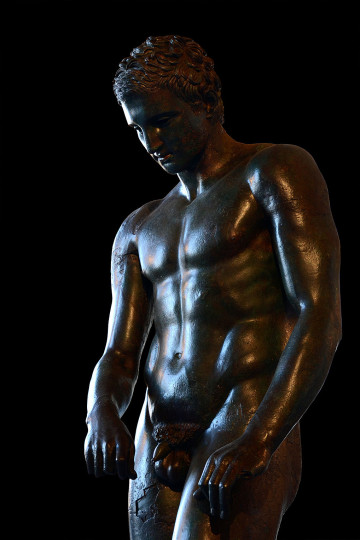In 1996, Belgian diver René Wauters made the archaeological discovery of a lifetime. Exploring the 45-metre-deep waters of Vele Orjule, a Croatian islet in the Adriatic Sea, he discovered a mysterious ancient bronze statue. Researchers would carefully study the statue for more than a decade to determine its age, origin and even the methods of its construction, thanks to nuclear techniques.

Naked and muscular, Apoxyomenos represents a male athlete scraping sweat and dust from his body. When the largely corroded statue was pulled from the sea in 1999, a long desalination and restoration process commenced. Upon completion in 2005, archaeologists were left puzzled: Apoxyomenos’s motif is not unique, so was this statue Roman or Greek? Pinning down its origins was impossible until 2009, when an accelerator helped to provide some clarity.
“Unraveling Apoxyomenos’s past relied on several nuclear techniques to better understand its structure at the atomic level,” said Lena Bassel, an associate project officer for heritage science at the IAEA. She works with experts from around the world in applying nuclear techniques for artefact characterization. Bassel points to a study published in the Journal of Archaeological Science in 2010 , where researchers, who had applied accelerator mass spectrometry to the organic material found inside Apoxyomenos, were able to carbon date the statue to between 100 BCE and 250 CE.
The researchers also applied accelerator-based micro-particle induced X-ray emission (PIXE) to determine the original composition of the alloy, and multi-collector inductively coupled plasma mass spectrometry to better understand the statue’s lead isotope composition. Isotopes are specific forms of a chemical element that vary by atomic mass and physical properties. Scientists can look at the ratio of different lead isotopes in a sample and cross reference it with known properties of geographical areas to identify where the sample came from. “They used the accelerator analytical technique to pinpoint the origins of the statue’s lead to the Eastern Alps or Sardinia, and concluded that the statue was a Roman copy of a Greek original,” said Bassel.

Researchers used accelerator-based techniques to pin down Apoxyomenos’s age, origin and methods of construction. (Photo: Vassil /Wikimedia Commons)
Five years later, researchers examined Apoxyomenos again using a high lateral resolution PIXE technique. They found the inlaid lips of the statue to be a very pure unalloyed copper. X-ray radiography revealed how the inlays were inserted and fastened into position, as well as the sophisticated casting and joining techniques of the limbs. The researchers concluded that Apoxyomenos was very clearly a copy of a much older — mid fourth century BCE — statue, made through an indirect lost-wax process casting technique that used an alloy with a low lead composition.
“Accelerator-based techniques have an important role in the characterization of heritage objects, and Apoxyomenos shows us that an approach using several types of analyses is often needed. The IAEA is fostering these applications,” said Bassel. Since 2018, the IAEA and its Members States have promoted the use of Atoms for Heritage, and last year established a strategic partnership with the University of Paris-Saclay in France to enhance the use of nuclear techniques in characterizing and preserving cultural and natural heritage. In collaboration with the IAEA, the university will focus on scientific research and development, and on transferring knowledge to and best practices with experts from around the world.

Romans risen from the Rhône
Nuclear techniques in archaeology are not limited to characterization, and irradiation has for a long time played an important role in artefact preservation. Famously, the 3200-year-old mummy of Egyptian Pharaoh Ramses II was irradiated in 1977 to remove fungi and insects, but the technology has been in continuous use in many other projects since.
In 2004, less than four metres below the surface of the Rhône River in Arles, France, a Roman ship from the first century CE was discovered. Dubbed the ‘Arles-Rhône 3’, the 31-metre-long oak barge was probably sunk by a flash flood that covered it in a layer of fine clay.
“The clay helped preserve the boat and its valuable artefacts, but anaerobic bacteria dissolved the wood’s cellulose, which was replaced with water. This posed a challenge in 2011 when researchers planned to raise the ship from the riverbed and install it in a museum, because, as it dried, the wood would collapse,” said Laurent Cortella, a research engineer from ARC-Nucléart, a restoration and conservation workshop in Grenoble.
ARC-Nucléart came up with a solution: they bathed the wood in polyethylene glycol, freeze-dried it, and treated parts of the boat with irradiation. “Like drying glue with a hairdryer, restorers used irradiation to solidify the radio-curable resin and keep the wood’s fibrous structure together,” said Bum Soo Han, a radiation chemist at the IAEA who is working within the Atoms for Heritage framework to promote the use of irradiation technologies in cultural preservation. Han offers technical support to cultural preservation efforts globally and sees demand for such applications growing.
“Arles-Rhône 3 can be visited today at the Departmental Museum of Ancient Arles, but you do not need to go to France to see artefact preservation by irradiation; such techniques are applied widely,” said Han. In 2017, the IAEA released Uses of Ionizing Radiation for Tangible Cultural Heritage Conservation, a publication showcasing the successful application of these techniques around the world. Han is now working on the next edition of that IAEA series, focusing on good practices in the disinfection of cultural heritage artefacts and archives using ionizing radiation. It is expected to be published in 2023.
